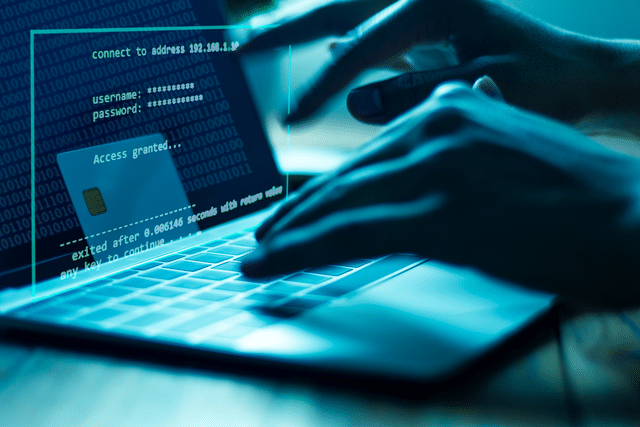Modern contact centers rely on both active and passive voice authentication to mitigate fraud risk and improve productivity. However, it’s important to understand that the underlying technologies between the two are vastly different.
In this article, we will discuss both active and passive authentication, explain how they work, and compare the two to determine which one you should choose for your contact center in 2025.
What is Active Authentication?
Active voice authentication (AVA) is an advanced biometric technology that utilizes unique voice characteristics for identity verification, providing a seamless and secure method of authenticating individuals.
This technology capitalizes on the fact that every individual’s voice is distinct, with unique features such as pitch, tone, modulation, and accent. AVA systems analyze these features using sophisticated algorithms and machine learning techniques to create a voiceprint, a digital model of an individual’s voice that serves as a biometric identifier.
Technically, active voice authentication systems utilize several key features: voice capture, feature extraction, and pattern matching. Initially, the user’s voice is captured through a recording device, typically a microphone.
This raw audio data is then processed to extract relevant features. This feature extraction involves analyzing various aspects of the voice signal, such as frequency content, temporal characteristics, and dynamic range.
Advanced signal processing techniques like Fourier transforms and Mel-frequency cepstral coefficients (MFCCs) are commonly employed in this phase to accurately capture the nuances of the voice. Also, it’s important to mention that all of this happens in real time!
Once the voice features are extracted, they are compared against a stored voiceprint in the authentication database using pattern-matching algorithms.
These algorithms, often leveraging deep learning techniques, are designed to account for minor variations in voice due to factors such as emotional state, health, or background noise, ensuring robust and accurate authentication.
The system’s decision to authenticate a user is based on the degree of similarity between the live voice sample and the stored voiceprint.
What is Passive Voice Authentication?
As you can probably tell, passive voice authentication (PVA) works in a slightly different manner. This is a sophisticated, non-intrusive method for verifying an individual’s identity based on their voice.
Unlike active voice authentication, which requires direct interaction from the user, PVA operates discreetly in the background, authenticating users during natural speech without the need for specific voice commands or phrases. This approach makes PVA an ideal solution for continuous authentication in various settings, enhancing both security and user experience.
Passive voice authentication works in the background, relying on ambient voice capture, feature extraction, and continuous pattern analysis. During ambient voice capture, the system unobtrusively records a user’s speech in a natural setting, often using strategically placed microphones or during regular phone conversations.
The challenge here is to accurately capture voice data amidst potential background noise and varying acoustic environments.
Once the voice is captured, certain features are extracted from it. This step involves isolating and analyzing distinct characteristics of the voice, such as timbre, intonation, and speech rhythm.
Techniques like Gaussian Mixture Models (GMMs) and Deep Neural Networks (DNNs) are employed to process these features and effectively differentiate between individual voices. Given the passive nature of the system, the algorithms must be particularly adept at handling unstructured and spontaneous speech, extracting relevant features from casual conversation.
The crux of passive voice authentication lies in its continuous pattern analysis, where the extracted voice features are constantly compared against a pre-established voiceprint in the system’s database.
Utilizing advanced machine learning algorithms, the system evaluates the probability that the voice in question matches the voiceprint associated with the user’s identity. This ongoing analysis allows for real-time authentication, flagging any discrepancies that might indicate fraudulent activity.
Active vs. Passive Voice Authentication – A Quick Overview
Here’s a brief table comparing the differences between the two:
Aspect |
Active Voice Authentication (AVA) |
Passive Voice Authentication (PVA) |
| Interaction Requirement | Requires direct user interaction (e.g., speaking a passphrase) | Operates in the background without direct user input |
| User Experience | The user must actively participate in the authentication process | Non-intrusive authenticates during natural speech |
| Typical Use Cases | Secure access to devices, systems, or facilities; voice-activated services | Contact centers for security monitoring |
| Speech Type | Structured, specific commands or phrases | Unstructured, natural conversation |
| Environmental Adaptation | Relies on clear, consistent voice quality | Must adapt to varied acoustic environments and background noises |
| Authentication Method | One-time verification at the point of access | Continuous, real-time monitoring and verification |
| Security | High, with distinct voice commands enhancing security | High, with continuous monitoring providing ongoing security |
| Voiceprint Storage | Stores a specific voiceprint based on known commands | Stores a more dynamic voiceprint to account for natural speech variations |
| Adaptability | Less adaptable to variations in voice | More adaptable to changes in voice and speech patterns |
Why is Passive Voice a Better Choice in Contact Centers?
Passive voice authentication is generally a better choice in contact centers for several reasons. For starters, passive voice authentication provides a non-disruptive experience, seamlessly operating in the background to authenticate callers during their natural speech patterns.
This feature is crucial in contact center environments where maintaining a smooth, customer-friendly interaction is essential. Unlike AVA, which requires specific voice commands or phrases for authentication, PVA doesn’t interrupt the conversation flow, allowing for a more natural and engaging customer experience.
Another major advantage of passive voice biometrics in the contact center is its ability to offer continuous authentication.
Passive voice authentication technology, such as Pindrop’s, runs in the background and offers real-time monitoring to ensure that the person on the line remains the authenticated caller throughout the entire interaction.
This ongoing verification is particularly important in contact centers to safeguard against fraud, making it much harder for an imposter to hijack a call partway through.
More importantly, passive voice biometrics saves a great deal of time and improves overall customer satisfaction. The seamless and unobtrusive nature of passive authentication is often preferred by customers who dislike undergoing repeated authentication processes, especially when they might call multiple times for ongoing issues.
Improve Your Contact Center’s Security Today
Pindrop’s passive voice authentication technology is used by some of the largest financial institutions in the country. If you’d like to see it in action and learn more about how it can benefit your business, request a demo today!



